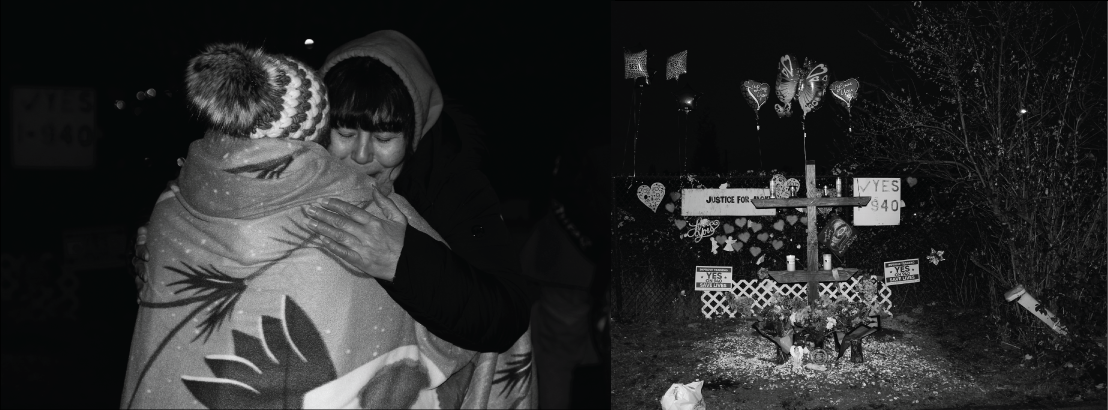Jacqueline Salyers Memorial Vigil
Lisa Earl receives a hug from a supporter | Jacqueline Salyers shrine was erected in 2016 after she was shot and killed by Tacoma Police.
As the winter sun sets on a Tacoma, Washington neighborhood, a community gathers before a large wooden cross. They bring flowers, balloons, and a pack of menthols to lay at an urban shrine, erected six years ago when Puyallup Tribal Member Jacqueline Salyers was shot and killed by police. Her mother Lisa Earl and uncle, Puyallup Tribal Councilmember James Rideout, rhythmically beat their hand-held drums as their song welcomes men, women, and children to Salyers’ yearly vigil.
When the singing subsides, everyone stands in a circle in front of the cross. Rideout addresses the crowd, expressing gratitude, “You bring us through the pain that helps the victims heal.” He continues, it’s “the pain that comes along when your loved one is taken in such a way that is so inhumane and unjust.”
On January 28, 2016, Tacoma Police Officers Aaron Joseph and Scott Campbell attempted to execute a warrant on Salyers’ boyfriend Kenneth Wright, who had guns in his possession. Salyers and Wright were seated in a parked car when Campbell alleges that 32-year-old Salyers started driving the vehicle towards him. He shot Salyers, who was pregnant and a mother of four, in the head, killing her. Wright, who escaped on foot, was caught weeks later and is currently incarcerated.
Salyers’ family challenges the Tacoma Police Department’s account of that night. The officers were not wearing body cams and, according to the Tacoma Police Department, a police surveillance camera that was installed on the street malfunctioned. The family believes the camera was tampered with, and because bullets from Campbell’s gun were found on the passenger side of the car, the family disputes his account that he was in danger of being hit. They also question why the officers, who knew Wright was armed and dangerous, never called for back-up.
Jacqueline Salyers' uncle, James Rideout, addresses supporters at his niece's yearly vigil in Tacoma, Washington.
At the time of Salyers’ death, a law in Washington state required that police officers had to show ‘malicious intent’ to be criminally liable for use of deadly force. Because of the clause, Joseph and Campbell were exonerated and the shooting of Salyers was found justified. Last year, Earl unsuccessfully sued officer Campbell for excessive force. She is appealing the court’s decision. The family is still seeking justice, however, and have been instrumental in leading a grassroots movement for police reform.
At the vigil, a portrait of Salyers is displayed on candles placed at her cross and on her mother’s sweatshirt. Lisa Earl recounts a Puyallup tradition, telling the circle of supporters, “We put loved ones’ pictures away, for a year at least. That hasn’t happened for Jackie,” she explains. “We had to show her face, use her name.” After Salyers was killed, her family helped lead a nation-wide effort to get I-940, a bill that annulled the malicious intent clause, as well as mandated de-escalation training for police, passed into law in 2018. And now, four years later, the family is hopeful about new police reform legislation that may provide an opportunity to re-examine the case and other cases like it.
Attendees to the vigil brought candles and cigarettes to lay at Salyers' cross.
Rideout expresses his frustration that Tacoma Police have not been held responsible for his niece’s death, “We fought back. Enough is enough. We spent endless days, months and years fighting back against a system that’s oppressed us, predominately people of color.” After the implementation of I-940, additional police reform bills have been signed into law. Last year, Washington Governor Jay Inslee signed over a dozen bills, including the creation of a new Office of Independent Investigations. The bill, if passed (it’s currently being debated in the state legislature), would retroactively look at deadly use of force incidents if new evidence comes to light. Rideout vows, “I’m going to fight for retro, for all cases prior to us changing the [I-940] law.” Salyers’ case is part of a larger systemic issue of police violence committed against Indigenous peoples.
Salyers’ story encapsulates a dismal set of statistics, the numbers reflecting a steep incline on the graph of bodily trauma. According to the National Institute of Justice, eighty-four percent of Native women experience violence in their lifetime. One overlooked statistic, however, is police killings. According to the CDC, per capita, Native men and women have the highest rates of police killings in the country. The impact of violence committed against Indigenous peoples forever impacts a family and a community as Salyers’ story highlights.
Standing before hand-made signs framing her daughter’s cross that read ‘Justice for Jackie’ and ‘Love, Healing, Prayers, Frybead,’ Earl says, “I want to sing a song, a lullaby for Jackie so that she’s at rest.” She pauses, “She has not been able to rest.” Continuing, Earl elucidates, “I’m hoping my baby is resting and knowing that we are not giving up and that we will continue to fight to make our communities safer for our children and families.” Earl then turns to face her daughter’s shrine. For a moment there is total silence until she begins to sing softly, her voice gently rising and falling with the beat of her brother’s drum.
Salyers' mother Lisa Earl at her daughter's vigil.



